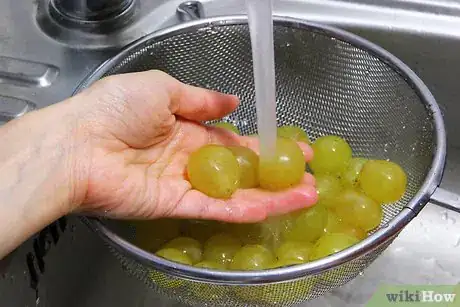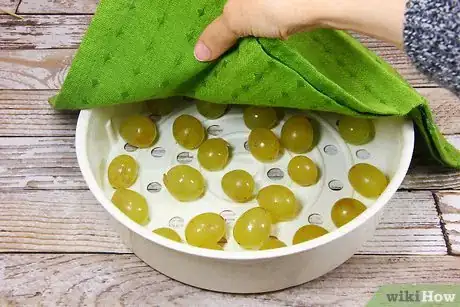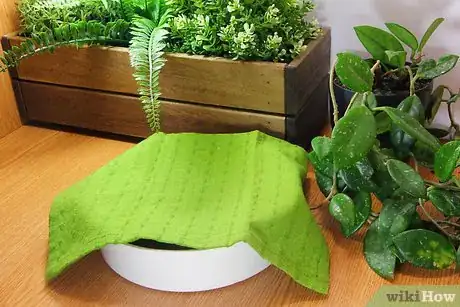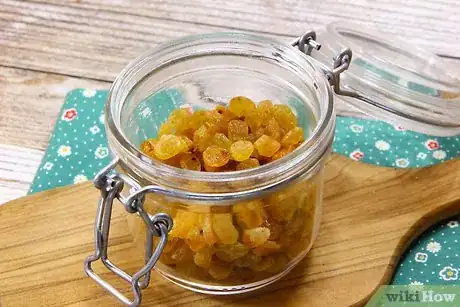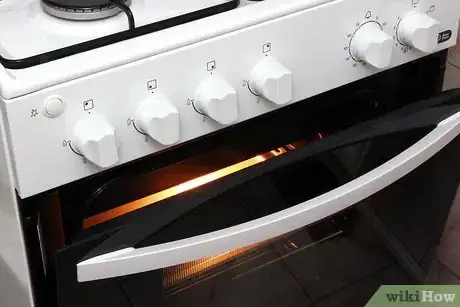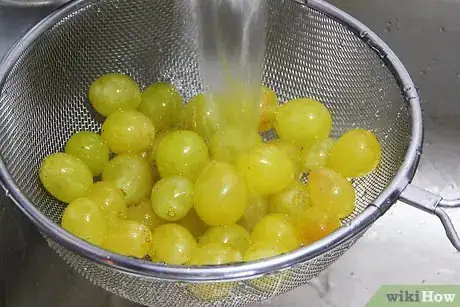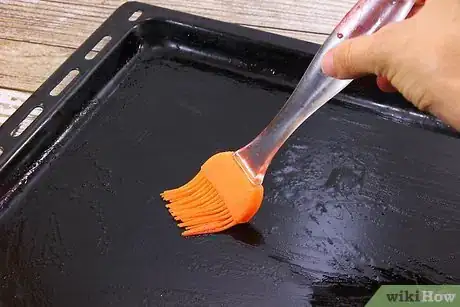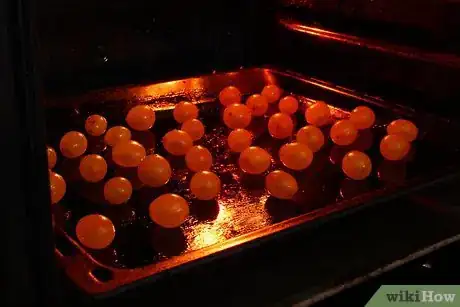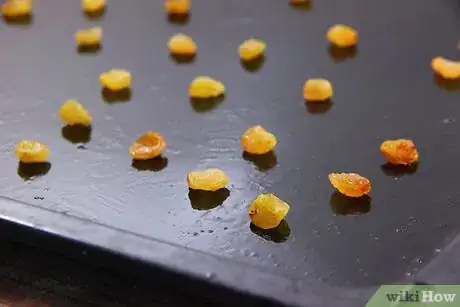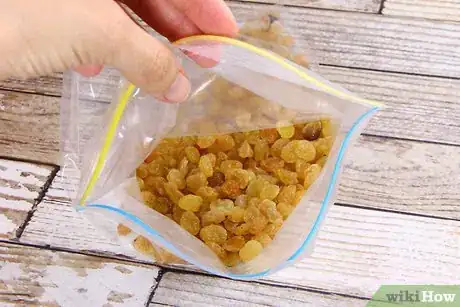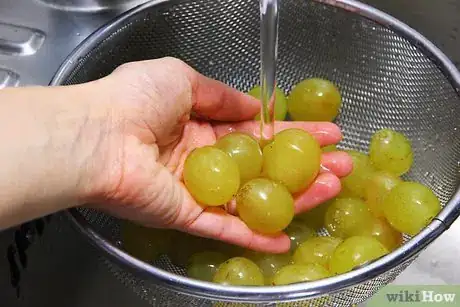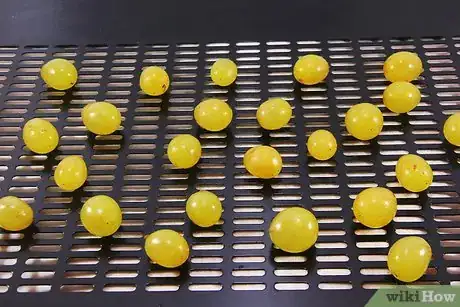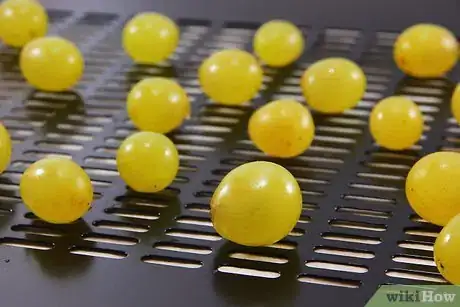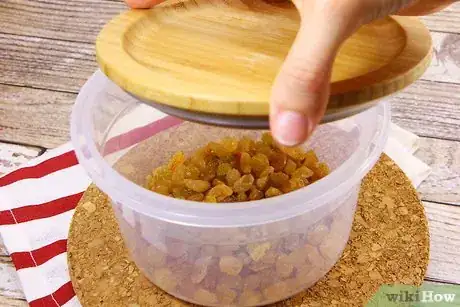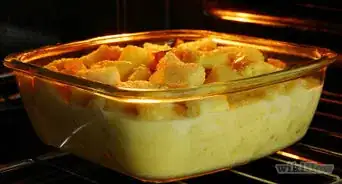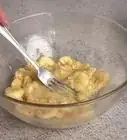This article was co-authored by wikiHow Staff. Our trained team of editors and researchers validate articles for accuracy and comprehensiveness. wikiHow's Content Management Team carefully monitors the work from our editorial staff to ensure that each article is backed by trusted research and meets our high quality standards.
This article has been viewed 456,509 times.
Learn more...
Raisins are a delicious natural snack that can be eaten on their own or added to a variety of recipes, such as oatmeal raisin cookies. In addition to being so versatile, they’re also easy to make! By simply drying grapes in the sun, in an oven, or in a dehydrator, you can easily make your own raisins in no time!
Steps
Drying Grapes in the Sun
-
1Remove the larger stems from your grapes and wash them thoroughly. You don’t need to remove all the grapes from the stems, but you should definitely cut off the larger stems. Rinse the grapes under running water to wash them.[1]
- You can also use an all-natural produce wash to wash your grapes, although simple water should suffice in most cases.
-
2Spread the grapes out evenly on a baking tray and cover them. Use a wooden, wicker, bamboo, or plastic tray that is slatted, so air can circulate around the fruit. Spread the grapes so that they aren’t touching one another on the tray. Use a kitchen towel to cover the grapes.[2]
- You can also use a pillowcase to cover your grapes if you’d rather not use a kitchen towel.
- Your cover should also be effective at keeping insects away from your grapes as they dry.
- Make sure that whatever you use to cover the grapes won’t get blown away in the wind. If your cover is relatively light, you may need to weigh it down on its corners.
Advertisement -
3Place the tray outside in the sun during warm, dry weather. Put the tray in a location where it will get lots of sunlight during the day. Only put them out during warm, dry weather; the warmer and dryer the climate, the easier your grapes will dry out.[3]
- If you put your tray out in overcast, cool, or particularly humid weather, the grapes will take longer to dry out (and may not even completely dry out). Aim to put your tray outside when the forecast is sunny, humidity is not too high, and the temperature is at least 75 °F (24 °C).
- If your area gets foggy or dewy at night, take the tray inside at the end of the day and place it outside again the next morning.
-
4Allow the grapes to sit outside for 3-4 days, rotating them occasionally. The grapes may take up to 96 hours to become sufficiently dry, depending on various weather conditions and how hydrated they were to start. However, they should be left outside for at least 3 days. Go out and rotate the grapes twice each day to make sure both sides of the grapes are exposed to the sun.[4]
- After 3 days, feel free to conduct a taste test on 1 or 2 of the grapes to see if they’re sufficiently dry. If they’re to your liking, go ahead and bring them inside. If they’re not quite dry enough, leave them out for another day.
- You can leave grapes out in the sun for up to 5 days, though you shouldn’t need to leave them out any longer than this.
-
5Take the dried raisins inside and store them in an airtight container. Once the grapes have dried to the point of becoming raisins, take the tray inside and place the raisins in an airtight container. Store the container in a cool place or refrigerate.[5]
- Suggested storage containers for air-dried raisins include mylar bags, tupperware, and glass canning jars with an oxygen absorber.
Making Raisins in the Oven
-
1Preheat your oven to 225 °F (107 °C). Set your oven temperature to 225 °F (107 °C) and allow it to preheat for about 15 minutes. Do not put your grapes in the oven before it’s preheated, as this will affect their quality.[6]
- This temperature will allow you to bake grapes into raisins in around 4 hours. If you’d rather make raisins more slowly, you can opt instead to set your oven to 150 °F (66 °C) and bake your grapes for around 36 hours. Making raisins more slowly takes much longer, but also reduces your risk of overcooking or overdrying your grapes.
-
2Wash your grapes and remove the stems. Run your grapes under running water to wash them. Use scissors or your fingers to remove any large stems from the grapes. Throw out any grapes that are spoiled.[7]
- All-natural produce wash can also be used to wash your grapes.
-
3Grease 2 baking sheets with oil and spread the grapes on them. Use a small amount of vegetable or canola oil to very lightly grease 2 rimmed baking sheets. Then, evenly spread your grapes out onto the sheets. Avoid having the grapes touch each other as much as possible.[8]
- You can also use parchment paper if you’d rather not place the grapes on oil.
- While you should spread your grapes out on the trays in a way that gives them space between each other, your raisins won’t be ruined if the grapes are touching each other.
-
4Bake your grapes in the oven for 4 hours or until they’re shriveled. You want your raisins to be mostly dried but still slightly plump. Check in several times during the baking process to avoid any mishaps. Feel free to remove the grapes after less than 4 hours if they’re sufficiently dried before then.[9]
- How long your grapes should cook for will vary based on their size and how dry you like your raisins. Larger grapes will take longer to dry out than smaller grapes.
-
5Remove the raisins from the oven and allow them to cool. Once the raisins are sufficiently dried, carefully remove them from the oven and allow them to cool for at least 30 minutes. If any raisins are stuck to the baking sheet, use a thin metal spatula to free them.[10]
-
6Store your raisins in a sealed container and refrigerate them. Once the raisins are completely cooled, transfer them to a sealable airtight container for storage. Place the container in the refrigerator to keep the raisins fresh.[11]
- Your raisins should keep in the refrigerator for up to 3 weeks.
Using a Dehydrator
-
1Wash your grapes and remove the seeds, if necessary. Use cool running water to remove any dirt or debris from your grapes before you place them in the dehydrator. If your grapes have seeds, cut the grapes in half and remove the seeds before proceeding.[12]
- If your grapes are seedless, there’s no need to cut them open.
- You can also wash your grapes with an all-natural produce wash.
-
2Spread the grapes out on the dehydrator trays. You don’t have to take great pains to evenly spread the grapes; it will be ok if they’re slightly touching each other. However, don’t overload the dehydrator with too many grapes, as this will negatively impact the drying process.[13]
- Be sure to closely follow the instructions for use with your dehydrator to know how best to avoid overloading it.
-
3Set the temperature on your dehydrator to 135 °F (57 °C). This is the temperature that is most commonly used to dehydrate grapes. If your dehydrator has a “fruit” setting, you may also use this setting.[14]
- Your machine may have a recommended temperature to use when dehydrating grapes. If so, set your dehydrator to this temperature. If it doesn’t include a recommended temperature, set it to 135 °F (57 °C).
-
4Allow your grapes to dehydrate for at least 24 hours. Most grapes require at least 24 hours to fully dehydrate, although some may take even longer to sufficiently dry. Check in on your grapes every 2 hours or so and taste test them; if they dry to your likeness in less than 24 hours, feel free to take them out of the dehydrator.[15]
- If your grapes are very small, they will likely need less than 24 hours to become raisins. Be more diligent about checking in on your grapes if they’re very small and make sure you don’t overcook them.
- Avoid dehydrating your grapes for more than 48 hours.
-
5Remove the grapes from the dehydrator and store them. After the grapes have been sufficiently dehydrated, remove them from the dehydrator and allow them to completely cool. Then, place them in an airtight container, such as a plastic bag or glass jar, and store.[16]
- Raisins made this way and stored in an airtight container can be stored in a cool, dry place (e.g., a pantry) for several months.
Community Q&A
Did you know you can get answers researched by wikiHow Staff?
Unlock staff-researched answers by supporting wikiHow
-
QuestionWhy do raisins not spoil?
 wikiHow Staff EditorThis answer was written by one of our trained team of researchers who validated it for accuracy and comprehensiveness.
wikiHow Staff EditorThis answer was written by one of our trained team of researchers who validated it for accuracy and comprehensiveness.
Staff Answer wikiHow Staff EditorStaff Answer
wikiHow Staff EditorStaff Answer -
QuestionWhat kind of grapes are used to make raisins?
 wikiHow Staff EditorThis answer was written by one of our trained team of researchers who validated it for accuracy and comprehensiveness.
wikiHow Staff EditorThis answer was written by one of our trained team of researchers who validated it for accuracy and comprehensiveness.
Staff Answer wikiHow Staff EditorStaff Answer
wikiHow Staff EditorStaff Answer -
QuestionHow long does it take for a grape to turn into a raisin?
 wikiHow Staff EditorThis answer was written by one of our trained team of researchers who validated it for accuracy and comprehensiveness.
wikiHow Staff EditorThis answer was written by one of our trained team of researchers who validated it for accuracy and comprehensiveness.
Staff Answer wikiHow Staff EditorStaff Answer
wikiHow Staff EditorStaff Answer
Things You'll Need
- Grapes
- Baking tray
- Kitchen towel
- Airtight storage container
- Rimmed baking sheets
- Oil or parchment paper
- Dehydrator
References
- ↑ https://www.seriouseats.com/recipes/2013/04/diy-raisins-recipe.html
- ↑ http://www.planet-science.com/categories/under-11s/our-world/2012/05/make-your-own-raisins.aspx
- ↑ https://frugallysustainable.com/how-to-make-raisins-from-fresh-grapes/
- ↑ https://frugallysustainable.com/how-to-make-raisins-from-fresh-grapes/
- ↑ https://frugallysustainable.com/how-to-make-raisins-from-fresh-grapes/
- ↑ https://www.seriouseats.com/recipes/2017/02/oven-dried-grapes-raisins-recipe.html
- ↑ https://www.seriouseats.com/recipes/2013/04/diy-raisins-recipe.html
- ↑ https://www.seriouseats.com/recipes/2017/02/oven-dried-grapes-raisins-recipe.html
- ↑ https://www.seriouseats.com/recipes/2017/02/oven-dried-grapes-raisins-recipe.html
- ↑ https://www.seriouseats.com/recipes/2017/02/oven-dried-grapes-raisins-recipe.html
- ↑ https://www.seriouseats.com/recipes/2017/02/oven-dried-grapes-raisins-recipe.html
- ↑ https://dontwastethecrumbs.com/2013/08/how-to-dehydrate-fruit-basic-food-preservation/
- ↑ https://dontwastethecrumbs.com/2013/08/how-to-dehydrate-fruit-basic-food-preservation/
- ↑ https://dontwastethecrumbs.com/2013/08/how-to-dehydrate-fruit-basic-food-preservation/
- ↑ https://dontwastethecrumbs.com/2013/08/how-to-dehydrate-fruit-basic-food-preservation/
- ↑ https://www.seriouseats.com/recipes/2013/04/diy-raisins-recipe.html
About This Article
To make raisins in the oven, preheat your oven to 225 °F, wash your grapes, and remove the stems. Next, lightly grease 2 baking sheets with oil and spread the grapes out on them. Then, place the baking sheets in the oven for 4 hours until the grapes look shriveled but still slightly plump. Finally, remove the raisins from the oven, let them cool for at least 30 minutes, and store them in an airtight container in the fridge for up to 3 weeks. To learn about making raisins with a dehydrator, read on!
